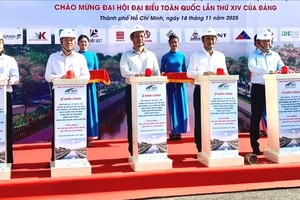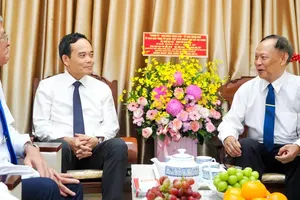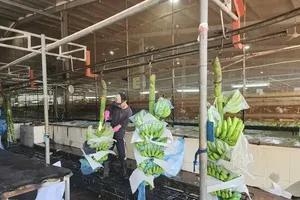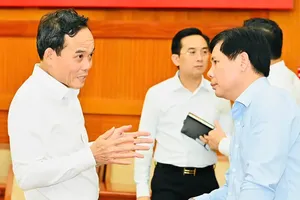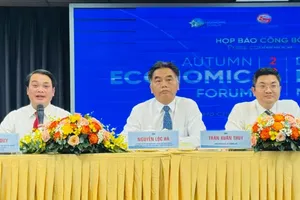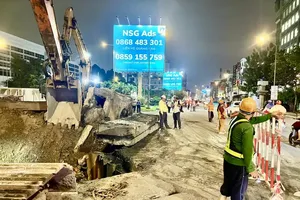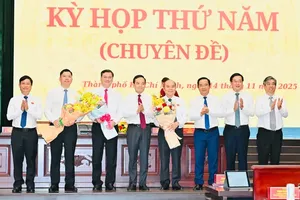
Yesterday afternoon, the Standing Committee of the Ho Chi Minh City Party Committee held a conference to study and disseminate the Resolution of the first Congress of the HCMC Party Committee for the 2025–2030 term. Secretary of the HCMC Party Committee Tran Luu Quang chaired the event.
The conference took place in person at the City Hall Auditorium at 111 Ba Huyen Thanh Quan Street in Xuan Hoa Ward and was broadcast online at 279 venues with the participation of 34,000 public servants and party members.
Clear goals for rapid and sustainable development
At the conference, Permanent Deputy Secretary of the HCMC Party Committee Le Quoc Phong set out major orientations focusing on three strategic breakthroughs such as institutional and policy improvements; synchronous and modern infrastructure development; and enhancing the quality of human resources.
He emphasized that the Resolution outlines 30 key indicators, 50 indicators, three breakthrough programs, and 10 groups of main tasks and solutions for the next five years. According to him, the city is aiming for robust economic growth, targeting an average GRDP growth of 10 percent–11 percent per year, which is expected to push GRDP per capita to US$14,000–US$15,000 by 2030.
Social development goals include achieving a Human Development Index (HDI) above 0.8, ensuring citizens receive free annual health check-ups or screenings starting in 2026, and increasing participation to over 95 percent in health insurance and 62 percent in social insurance.
Moreover, for urban development, the plan is to raise the ratio of transportation land to total construction area to between 16 percent and 26 percent, grow urban green space to 11 percent, add 199,400 social housing units by the end of 2030, and renovate 50 percent of makeshift houses along canals before 2030. Finally, in the defense and security sectors, the city plans to ensure 100 percent annual military recruitment and have over 50 percent of local areas free of crime and social vices.
Moreover, from 2026, residents will have annual free health check-ups or screening. Plus, over 95 percent of the population is covered by health insurance and 62 percent of the workforce is covered by social insurance.
In urban development, the city aims to increase land for transportation to 16 percent–26 percent of built-up areas, raise urban green space to 11 percent, add 199,400 social housing units by the end of 2030, and renovate 50 percent of temporary housing along canals before 2030.
In defense and security, the city strives to achieve 100 percent annual conscription targets and ensure that over 50 percent of wards, communes, and special administrative units are free of crime and social evils.
Breakthroughs in institutions, infrastructure, and human resources

Ho Chi Minh City will continue removing bottlenecks related to land, public investment, and pending construction projects while proposing amendments and supplements to Resolution 98 to better align with development needs.
In addition, the city will intensify public communication efforts to ensure voters fully understand the significance and importance of the election while at the same time safeguarding security, public order, and information safety, strengthening cybersecurity measures, and applying information technology throughout the entire electoral process.
Regarding infrastructure, the city will strengthen regional connectivity through external transport systems, develop urban railways, seaports, airports, digital infrastructure, drainage systems, and waterways.
In human resources, the city aims to modernize education—standardizing training, applying artificial intelligence, and building special policies to attract and retain high-quality talent.
Ten key task groups in the Action Program

Vice Secretary of the Ho Chi Minh City Party Committee Dang Minh Thong presented the Action Program for implementing the Resolution, centering on 10 major tasks and solutions, including restructuring the economy with a focus on science–technology and innovation, comprehensive and effective digital transformation and green transition, developing a knowledge-based and creative economy with deeper integration into global value chains.
Additionally, the city will redesign urban space with a multi-hub, integrated, super-connected approach, promote cultural values and building the identity of HCMC residents while strengthening environmental protection, resource management, and climate resilience.
Personnel work and preparation for upcoming elections

Chairman of the Ho Chi Minh City People’s Council Vo Van Minh stated that preparations for the election of the 16th National Assembly and the People’s Councils at all levels for the 2026–2031 term are on schedule. Personnel work is identified as decisive, with the goal of selecting candidates with competence, integrity, and strategic thinking.
The city will intensify communication to help voters understand the importance of the election, ensure security and information safety, and enhance cybersecurity throughout the process.
Key challenges in governance

Secretary Tran Luu Quang pointed out the four tasks assigned by the General Secretary at the first Congress of the HCMC Party Organization including flood mitigation, traffic congestion reduction, air pollution control, working toward a “drug-free city”.
He emphasized that the city currently has the most favorable mechanisms ever, including those under the former Resolution 54 and the current Resolution 98.
However, the city also faces significant challenges such as administrative bottlenecks due to high workload, shortage of high-quality human resources, and slow progress in restructuring administrative units and inventorying public assets.

